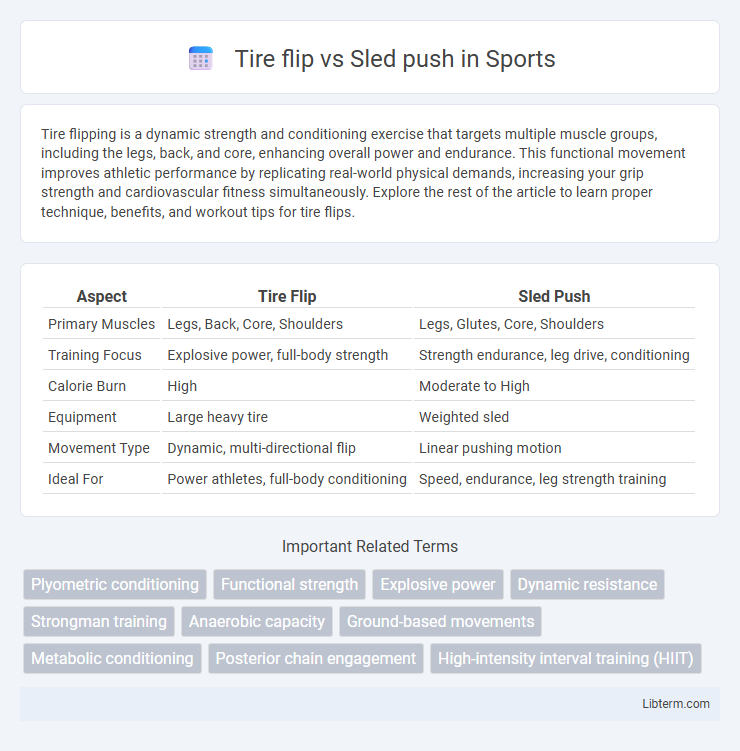Tire flipping is a dynamic strength and conditioning exercise that targets multiple muscle groups, including the legs, back, and core, enhancing overall power and endurance. This functional movement improves athletic performance by replicating real-world physical demands, increasing your grip strength and cardiovascular fitness simultaneously. Explore the rest of the article to learn proper technique, benefits, and workout tips for tire flips.
Table of Comparison
| Aspect | Tire Flip | Sled Push |
|---|---|---|
| Primary Muscles | Legs, Back, Core, Shoulders | Legs, Glutes, Core, Shoulders |
| Training Focus | Explosive power, full-body strength | Strength endurance, leg drive, conditioning |
| Calorie Burn | High | Moderate to High |
| Equipment | Large heavy tire | Weighted sled |
| Movement Type | Dynamic, multi-directional flip | Linear pushing motion |
| Ideal For | Power athletes, full-body conditioning | Speed, endurance, leg strength training |
Introduction: Tire Flip vs Sled Push
Tire flips target explosive power and full-body strength by engaging muscles in the legs, back, and core through a dynamic lifting and flipping motion. Sled pushes emphasize lower body endurance and anaerobic capacity by driving force against resistance while maintaining a strong, forward-leaning posture. Both exercises enhance athletic performance but prioritize different muscle groups and training goals.
Exercise Overview: What Are Tire Flips and Sled Pushes?
Tire flips involve lifting and flipping a large, heavy tire to build explosive strength, power, and full-body coordination, primarily targeting the legs, back, and core muscles. Sled pushes require pushing a weighted sled across a surface to enhance lower body strength, conditioning, and muscular endurance, engaging the quads, glutes, and calves. Both exercises are dynamic functional movements used in strength training and athletic conditioning for overall power development.
Muscle Groups Targeted
Tire flips primarily target the quadriceps, hamstrings, glutes, and lower back muscles while engaging the core and upper body for stability and power. Sled pushes emphasize the quadriceps, glutes, and calves, recruiting the core and shoulders to maintain posture and drive force. Both exercises enhance overall lower body strength and conditioning but differ in their emphasis on explosive power versus sustained force.
Strength and Power Development
Tire flips develop explosive strength by engaging multiple muscle groups, including the legs, back, and core, enhancing overall power output. Sled pushes target lower body strength and anaerobic endurance, emphasizing force generation through sustained muscle contractions. Both exercises improve functional strength but tire flips prioritize dynamic power while sled pushes build consistent force production.
Cardiovascular and Conditioning Benefits
Tire flips enhance cardiovascular endurance by engaging multiple large muscle groups in a high-intensity, dynamic movement that elevates heart rate rapidly. Sled pushes provide sustained, controlled resistance that improves muscular endurance and boosts cardiovascular conditioning through prolonged, steady exertion. Both exercises effectively increase anaerobic capacity, but tire flips offer greater explosive power development while sled pushes emphasize endurance and stamina.
Functional Movement Comparison
The tire flip and sled push are both powerful functional movements that target multiple muscle groups but emphasize different strength and endurance aspects. Tire flips primarily develop explosive power and full-body coordination by engaging the posterior chain, core stability, and grip strength through dynamic lifting and flipping motions. The sled push focuses on improving lower body strength, cardiovascular conditioning, and anaerobic capacity with a sustained, forward-driving force emphasizing quadriceps, glutes, and core stabilization.
Skill and Technique Requirements
Tire flip demands explosive power, coordination, and proper hip hinge technique to safely lift and propel the tire, emphasizing full-body strength and dynamic movement patterns. Sled push requires consistent driving force through the legs, core stability, and efficient foot placement to maintain forward momentum, highlighting endurance and controlled breathing. Both exercises develop functional strength but differ in motion mechanics, with tire flips focusing on lift and thrust, while sled pushes emphasize sustained force and posture.
Injury Risk and Safety Considerations
Tire flips and sled pushes present distinct injury risks tied to their specific biomechanics; tire flips can strain the lower back and shoulders due to the explosive lifting motion, while sled pushes primarily challenge the knees and ankles with repetitive impact and forceful extension. Safety considerations include proper form and gradual progression in weight and intensity to prevent muscle strains, joint stress, and overuse injuries in both exercises. Using appropriate equipment and ensuring a stable surface also reduces the likelihood of slips, falls, and acute injuries during these high-intensity training movements.
Programming: When to Use Tire Flips or Sled Pushes
Tire flips excel in explosive power development and full-body engagement, making them ideal for high-intensity interval training or conditioning circuits. Sled pushes prioritize controlled strength and endurance, suitable for low-impact recovery days or strength-focused programming. Selecting between tire flips and sled pushes depends on training goals, with tire flips enhancing maximal power and sled pushes building sustained muscular endurance.
Which Exercise is Best for You?
Choosing between tire flips and sled pushes depends on your fitness goals and physical condition. Tire flips are ideal for developing full-body strength and explosive power, targeting muscles in the legs, core, and upper body through dynamic, compound movements. Sled pushes focus more on building lower body strength and endurance with controlled, linear motion, making them suitable for improving speed, stability, and cardiovascular fitness.
Tire flip Infographic

 libterm.com
libterm.com